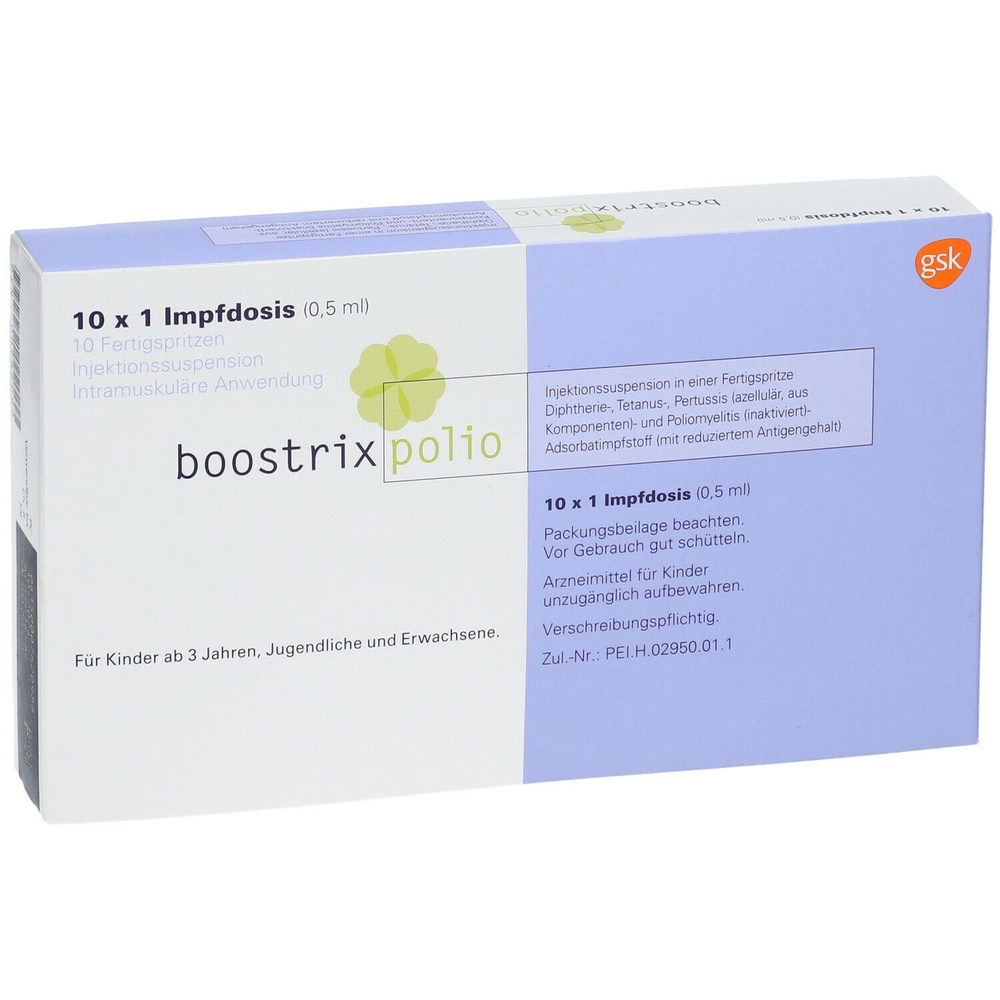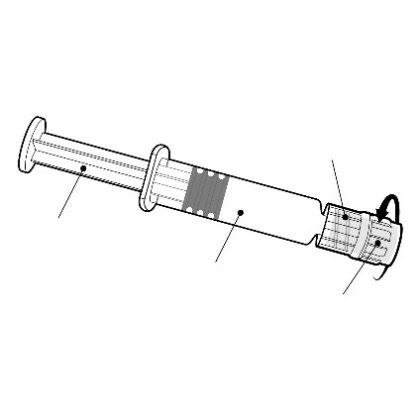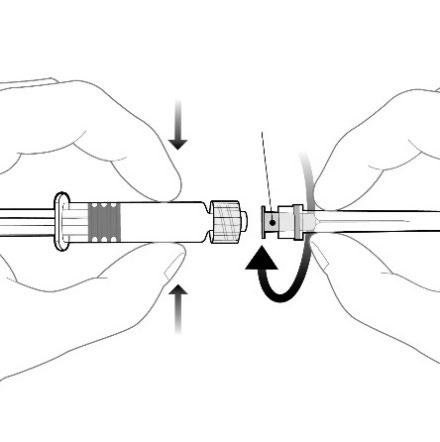

Boostrix Polio

Ask a doctor about a prescription for Boostrix Polio

How to use Boostrix Polio
Leaflet accompanying the packaging: information for the user
Boostrix Polio, Suspension for injection in a pre-filled syringe
Vaccine against diphtheria, tetanus, pertussis (acellular, composite) and poliomyelitis (inactivated), adsorbed, with reduced antigen content
You should carefully read the contents of the leaflet before using the vaccine, as it contains important information for the patient.
- You should keep this leaflet, so that you can read it again if you need to.
- If you have any further questions, ask your doctor or pharmacist.
- This medicine has been prescribed for you. Do not pass it on to others. It may harm them, even if their symptoms are the same as yours.
- If you experience any side effects, including any not listed in this leaflet, please inform your doctor or pharmacist. See section 4.
Table of contents of the leaflet:
- 1. What is Boostrix Polio and what is it used for
- 2. Important information before using Boostrix Polio
- 3. How to use Boostrix Polio
- 4. Possible side effects
- 5. How to store Boostrix Polio
- 6. Contents of the pack and other information
1. What is Boostrix Polio and what is it used for
Boostrix Polio is a vaccine used for booster vaccination of children from 3 years of age, adolescents and adults to prevent four diseases: diphtheria, tetanus, pertussis (whooping cough) and poliomyelitis (polio). The vaccine causes the body to produce its own immunity (antibodies) against these diseases.
- Diphtheria:Diphtheria usually affects the respiratory tract and sometimes the skin. Typically, inflammation and swelling occur in the respiratory tract, causing severe breathing difficulties and sometimes suffocation. Diphtheria bacteria also produce toxins that can cause nerve damage, heart disease, and even death.
- Tetanus:Tetanus bacteria enter the human body through a cut, scratch, or wound in the skin. Injuries that pose the greatest risk of tetanus infection include: burns, fractures, deep or dirty wounds, wounds contaminated with soil, dust, horse dung, or wood splinters. These bacteria produce toxins that can cause muscle stiffness, painful muscle spasms, convulsions, and even death. Muscle spasms can be so strong that they lead to spinal fractures.
- Pertussis (whooping cough):Pertussis is a highly contagious disease. The disease affects the respiratory tract, causing severe coughing attacks that can make breathing difficult. The cough in this disease is very characteristic - people with pertussis are said to "cough violently". The cough can last for 1-2 months or longer. Pertussis bacteria can also cause ear infections, bronchitis, which can last a long time, pneumonia, convulsions, brain damage, and even death.
- Poliomyelitis (polio):Poliomyelitis, sometimes simply called polio, is a viral infection characterized by many symptoms. Often it is a mild disease, but in some people, it can cause permanent damage and even death. In the most severe form of the disease, there is paralysis of the muscles (muscles cannot perform their functions), which can be paralysis of the respiratory muscles or those that enable independent movement. Affected limbs can be deformed and painful.
None of the components of the vaccine can cause diphtheria, tetanus, pertussis, or poliomyelitis. The use of Boostrix Polio during pregnancy helps protect the baby against pertussis during the first few months of life, before the baby receives primary vaccination.
2. Important information before using Boostrix Polio
When not to use Boostrix Polio:
- if you have ever had an allergic reaction (hypersensitivity) to Boostrix Polio or any of its components (listed in section 6) as well as neomycin, polymyxin (antibiotics) or formaldehyde. Allergy symptoms include: itchy skin rash, difficulty breathing, swelling of the face or tongue.
- if you have ever had an allergic reaction to any vaccine against diphtheria, tetanus, pertussis (whooping cough) or poliomyelitis.
- if you have had any nervous system disorders within 7 days of previous administration of pertussis vaccine.
- if you have had a temporary decrease in platelet count (which increases the risk of bleeding or bruising) or brain and nerve disorders after previous diphtheria or tetanus vaccinations.
- if you have a high fever (above 38.0 ° C). A mild infection, such as a cold, should not be a contraindication to vaccination, but you should first tell your doctor about it.
Warnings and precautions
Before receiving Boostrix Polio, tell your doctor or pharmacist:
- if you have ever had health problems after receiving Boostrix Polio or another pertussis vaccine, especially:
- High fever (above 40 ° C) within 48 hours of vaccination
- Shock or shock-like state within 48 hours of vaccination
- Persistent crying lasting at least three hours within 48 hours of vaccination
- Seizures or febrile seizures within 3 days of vaccination
- if your child has an undiagnosed or progressive brain disease or uncontrolled epilepsy. The vaccine should be given after the disease has been controlled
- if you have bleeding or bruising
- if you have a tendency to febrile seizures or if such cases have occurred in your family
- if you have long-term immune system disorders (including HIV infection). In such cases, Boostrix Polio may be given, but vaccinated patients may not develop as good protection against infections as people with a normal immune system.
After or even before receiving each vaccine injection, fainting (especially in adolescents) may occur. Therefore, you should inform your doctor or nurse if you have ever fainted during an injection. As with any vaccine, it is possible that not all vaccinated individuals will develop a protective immune response.
Boostrix Polio and other medicines
Tell your doctor or pharmacist about all the medicines you are taking or have recently taken, as well as any medicines you plan to take and any vaccines you have recently received. Boostrix Polio can be given at the same time as some other vaccines. Each vaccine will be given at a different site. Boostrix Polio may not work properly if given at the same time as medicines that reduce the body's ability to fight infections.
Pregnancy and breastfeeding
If you are pregnant or breastfeeding, think you may be pregnant or plan to have a child, ask your doctor or pharmacist for advice before using this vaccine. It is not known whether Boostrix Polio passes into breast milk. Your doctor will discuss with you the potential risks and benefits of using Boostrix Polio during breastfeeding.
Driving and using machines
It is unlikely that Boostrix Polio will affect your ability to drive or use machines.
Boostrix Polio contains neomycin and polymyxin
Boostrix Polio contains neomycin and polymyxin (antibiotics). You should tell your doctor if you have ever had an allergic reaction to these substances.
Boostrix Polio contains para-aminobenzoic acid, phenylalanine, sodium, and potassium
Boostrix Polio contains para-aminobenzoic acid. It can cause allergic reactions (possible late reactions) and very rarely bronchospasm. The vaccine contains 0.0298 micrograms of phenylalanine per dose. Phenylalanine can be harmful to patients with phenylketonuria (PKU), a rare genetic disorder in which phenylalanine accumulates in the body because the body does not remove it properly. This vaccine contains less than 1 mmol (23 mg) of sodium per dose, which means the vaccine is considered "sodium-free". This vaccine contains potassium, less than 1 mmol (39 mg) of potassium per dose, which means the vaccine is considered "potassium-free".
3. How to use Boostrix Polio
- Boostrix Polio will be given as an intramuscular injection.
- Under no circumstances should the vaccine be given intravascularly.
- You will receive a single dose of the vaccine.
- Your doctor will determine if you have been previously vaccinated against diphtheria, tetanus, pertussis, and/or poliomyelitis.
- Boostrix Polio may be used if there is a suspicion of tetanus infection due to injury. Your doctor will also take additional measures such as wound care and/or administration of tetanus antitoxin to reduce the risk of the disease.
Your doctor will inform you if a booster dose of the vaccine is necessary.
4. Possible side effects
Like all medicines, this vaccine can cause side effects, although not everybody gets them. As with all injectable vaccines, there is a very small risk (less than 1 in 10,000 doses of the vaccine) of anaphylactic and anaphylactoid reactions. Such a condition can be recognized by the following symptoms:
- Rash, which may be itchy or blistering,
- Swelling of the eyes and face,
- Difficulty breathing and swallowing,
- Sudden drop in blood pressure and loss of consciousness.Such reactions usually occur before leaving the doctor's office. However, in any such case, you should immediately contact your doctor.
Side effects that occurred in clinical trials in children aged 4 to 8:
Very common(may occur more often than 1 in 10 doses of the vaccine): pain, redness, and swelling at the injection site, drowsiness.
Common(may occur up to 1 in 10 doses of the vaccine): fever equal to or higher than 37.5 °C (including fever higher than 39 °C), bleeding, itching, and hard lump at the injection site, extensive swelling of the limb into which the vaccine was administered, loss of appetite, irritability, headache.
Uncommon(may occur up to 1 in 100 doses of the vaccine): diarrhea, nausea, vomiting, abdominal pain, swelling of the lymph nodes in the neck, armpits, or groin (lymphadenopathy), sleep disorders, apathy, dry throat, fatigue.
Concomitant administration with measles, mumps, and rubella (MMR) or measles, mumps, rubella, and varicella (MMRV) vaccines in children aged 3-6
In studies where Boostrix Polio was given at the same time as MMR or MMRV vaccines, skin rash and upper respiratory tract inflammation (including runny nose and sore throat) were regularly reported. Fever, irritability, fatigue, loss of appetite, and gastrointestinal disorders (including diarrhea and vomiting) were reported more frequently (very common) than in studies where only Boostrix Polio was administered.
Side effects that occurred in clinical trials in adults, adolescents, and children from 10 years of age:
Very common(may occur more often than 1 in 10 doses of the vaccine): pain, redness, and swelling at the injection site, fatigue, headache.
Common(may occur up to 1 in 10 doses of the vaccine): fever equal to or higher than 37.5 °C, hematoma, itching, hard lump, feeling of heat, numbness at the injection site, abdominal pain, nausea, vomiting.
Uncommon(may occur up to 1 in 100 doses of the vaccine): fever above 39 °C, extensive swelling of the limb into which the vaccine was administered, chills, pain, dizziness, joint and muscle pain, itching, cold sore, swelling of the lymph nodes in the neck, armpits, or groin (lymphadenopathy), decreased appetite, tingling or numbness of the hands or feet (paresthesia), drowsiness, asthma.
The following side effects have been reported during routine use of Boostrix Polio and are not specific to any age group: fainting or loss of consciousness, swelling of the face, lips, mouth, tongue, or throat, which can cause difficulty swallowing or breathing (angioedema), seizures (with or without fever), blisters (hives), unusual weakness (asthenia).
Additionally, the following side effects have been reported during clinical trials of another diphtheria, tetanus, and pertussis (acellular) vaccine with reduced antigen content from GlaxoSmithKline Biologicals (Boostrix):
Side effects that occurred in clinical trials in children aged 4 to 8:
Uncommon(may occur up to 1 in 100 doses of the vaccine): attention disorders, eye discharge and itching, conjunctivitis, pain.
Side effects that occurred in clinical trials in adults, adolescents, and children from 10 years of age:
Very common(may occur more often than 1 in 10 doses of the vaccine): general malaise.
Common(may occur up to 1 in 10 doses of the vaccine): hard lump or abscess at the injection site.
Uncommon(may occur up to 1 in 100 doses of the vaccine): upper respiratory tract infection, sore throat and difficulty swallowing (pharyngitis), fainting, cough, diarrhea, increased sweating, rash, joint stiffness, musculoskeletal stiffness, flu-like symptoms such as fever, sore throat, runny nose, cough, and chills.
After administration of tetanus vaccines, very rarely (less than 1 in 10,000 doses of the vaccine), transient neurological disorders have been reported, causing pain, weakness, and paralysis of the limbs, often including the chest and face (Guillain-Barré syndrome).
Reporting side effects
If you experience any side effects, including any not listed in this leaflet, please inform your doctor or pharmacist. Side effects can be reported directly to the Department of Drug Safety Monitoring of the Office for Registration of Medicinal Products, Medical Devices, and Biocidal Products:
Al. Jerozolimskie 181C
02-222 Warsaw
Phone: 22 49 21 301
Fax: 22 49 21 309
Website: https://smz.ezdrowie.gov.pl
Side effects can also be reported to the marketing authorization holder.
By reporting side effects, you can help provide more information on the safety of this medicine.
5. How to store Boostrix Polio
Keep out of the sight and reach of children.
Do not use this vaccine after the expiry date stated on the carton and on the label of the pre-filled syringe after "EXP". The expiry date refers to the last day of the month stated.
Store in a refrigerator (2 °C - 8 °C).
Do not freeze. Freezing destroys the vaccine.
Store in the original package to protect from light.
Medicines should not be disposed of via wastewater or household waste. Ask your pharmacist how to dispose of medicines no longer required. These measures will help protect the environment.
6. Contents of the pack and other information
What Boostrix Polio contains
- The active substances of the vaccine are:
Diphtheria toxoid
not less than 2 international units (IU) (2.5 Lf)
Tetanus toxoid
not less than 20 international units (IU) (5 Lf)
Bordetella pertussisantigens
Pertussis toxoid
8 micrograms
Filamentous hemagglutinin
8 micrograms
Pertactin
2.5 micrograms
Inactivated poliovirus
type 1 (Mahoney strain)
40 D antigen units
type 2 (MEF-1 strain)
8 D antigen units
type 3 (Saukett strain)
32 D antigen units
adsorbed on hydrated aluminum hydroxide (Al(OH))
0.3 milligrams Al
and on aluminum phosphate (AlPO)
0.2 milligrams Al
grown in VERO cell culture
Aluminum hydroxide and aluminum phosphate serve as adjuvants in this vaccine. Adjuvants are substances that are part of some vaccines and are intended to accelerate, enhance, and/or prolong the protective effect of the vaccine.
- Other ingredients of the Boostrix Polio vaccine are: Medium 199 (containing amino acids (including phenylalanine), mineral salts (including sodium and potassium), vitamins (including para-aminobenzoic acid) and other substances), sodium chloride, water for injections.
What Boostrix Polio looks like and contents of the pack
Suspension for injection in a pre-filled syringe.
Boostrix Polio is a white, slightly milky liquid in a pre-filled syringe (0.5 ml).
Boostrix Polio is available in a 1-dose pre-filled syringe, in packs of 1 or 10, with or without needles.
Not all pack sizes may be marketed.
Marketing authorization holder and manufacturer
GlaxoSmithKline Biologicals S.A.
rue de l’Institut 89
1330 Rixensart, Belgium
This medicinal product is authorized in the Member States of the European Economic Area under the following names:
Boostrix Polio:Austria, Belgium, Bulgaria, Czech Republic, Denmark, Finland, Greece, Spain, Netherlands, Iceland, Lithuania, Luxembourg, Latvia, Germany, Norway, Poland, Portugal, Slovakia, Slovenia, Sweden, Hungary
Boostrix Tetra:France
IPV-Boostrix:Ireland, Malta
Polio Boostrix:Italy
Boostrix IPV:Romania
Date of last revision of the leaflet:04/2023
Other sources of information
Detailed information on this medicine is available on the website of the Office for Registration of Medicinal Products, Medical Devices, and Biocidal Products
-------------------------------------------------------------------------------------------------------------------------
Information intended for healthcare professionals only:
Before administration, the vaccine should be at room temperature. The pre-filled syringe should be shaken vigorously to obtain a homogeneous, cloudy, white suspension.
Before administration, the vaccine should be visually inspected for any foreign particles and/or changes in the physical appearance of the vaccine. If any are found, the vaccine should not be administered.
Instructions for the pre-filled syringe

Hold the pre-filled syringe by the body, not by the plunger.
Unscrew the nozzle of the pre-filled syringe by twisting it in the opposite direction to the clockwise direction.
Luer Lock adapter
Plunger
Body
Nozzle
Attach the needle to the pre-filled syringe by connecting the needle nozzle to the Luer Lock adapter (LLA) and twisting it a quarter turn in the clockwise direction until the needle is locked.
Do not pull the plunger out of the pre-filled syringe body. If this happens, do not administer the vaccine.

Needle nozzle
Removal
Any unused product or waste material should be disposed of in accordance with local regulations.
- Country of registration
- Active substance
- Prescription requiredYes
- Manufacturer
- ImporterGlaxoSmithKline Biologicals S.A.
- This information is for reference only and does not constitute medical advice. Always consult a licensed doctor before taking any medication. Oladoctor is not responsible for medical decisions based on this content.
- Alternatives to Boostrix PolioDosage form: Suspension, 0.5 mlActive substance: diphtheria-pertussis-poliomyelitis-tetanusManufacturer: Sanofi-Aventis Zrt.Prescription requiredDosage form: Suspension, 1 dose (0.5 ml)Active substance: diphtheria-pertussis-poliomyelitis-tetanusManufacturer: GlaxoSmithKline Biologicals S.A.Prescription requiredDosage form: Powder, 32 antigen units D + 10 mcg + not less than 40 IU + 8 antigen units D + 40 antigen units D + not less than 30 IU + 25 mcg + 25 mcgActive substance: diphtheria-pertussis-poliomyelitis-tetanusPrescription required
Alternatives to Boostrix Polio in other countries
The best alternatives with the same active ingredient and therapeutic effect.
Alternative to Boostrix Polio in Spain
Alternative to Boostrix Polio in Ukraine
Online doctors for Boostrix Polio
Discuss dosage, side effects, interactions, contraindications, and prescription renewal for Boostrix Polio – subject to medical assessment and local rules.











